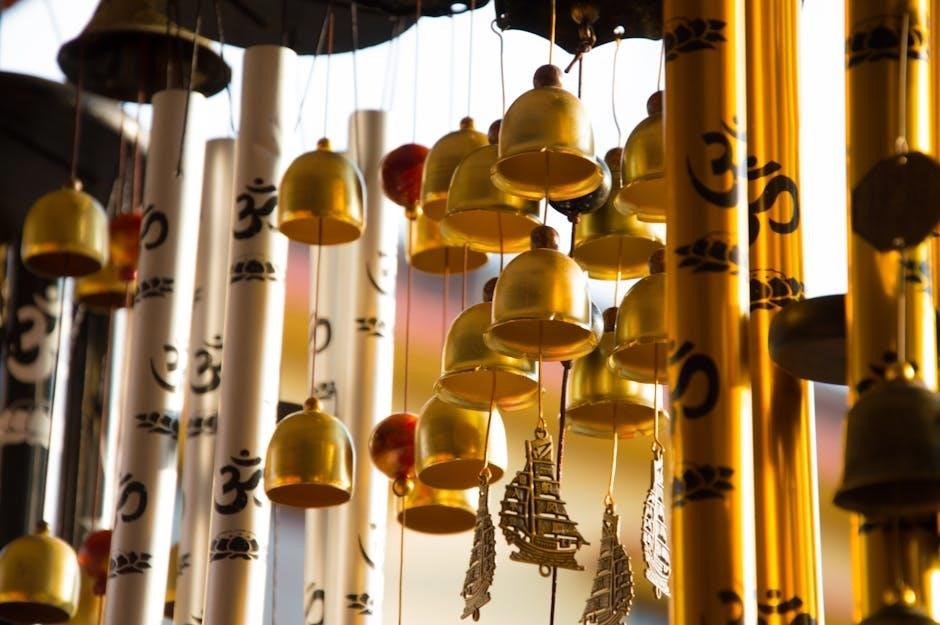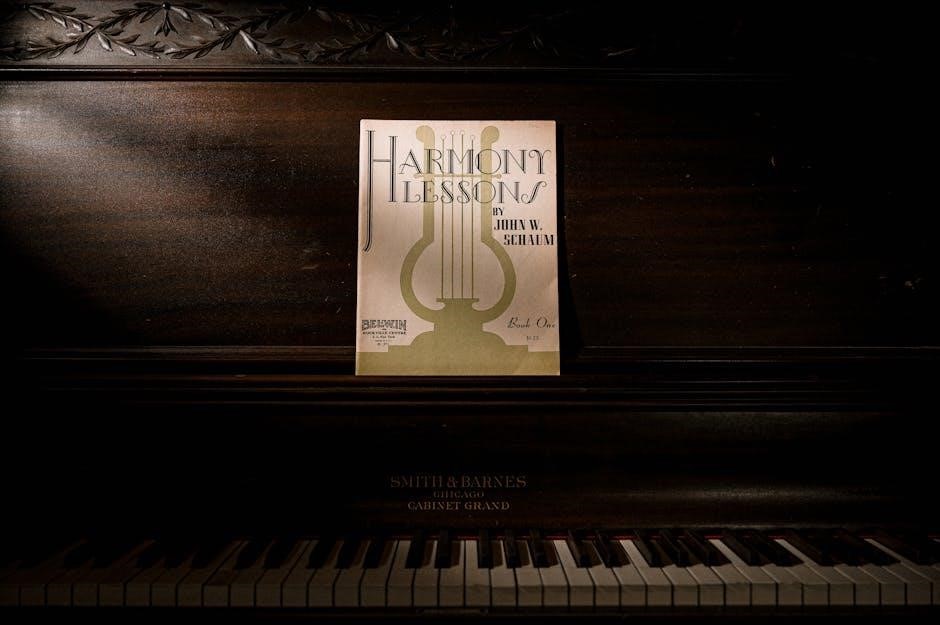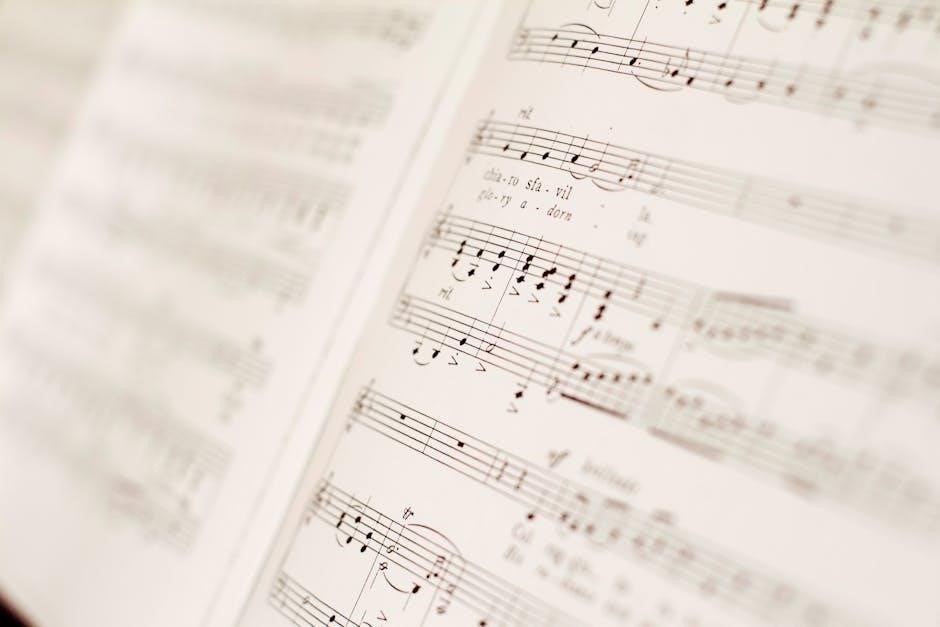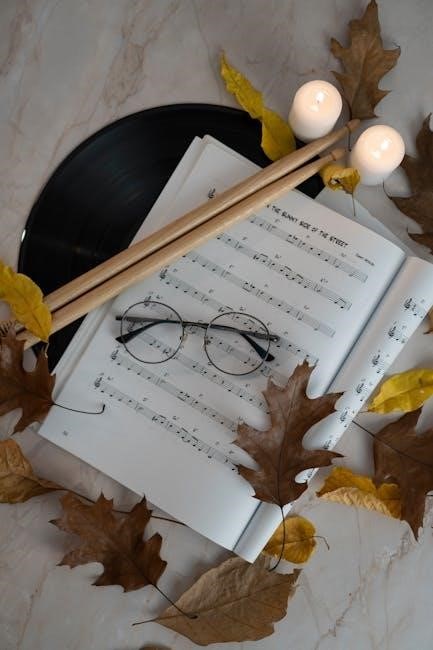“Carol of the Bells” is a traditional Ukrainian carol composed by Mykola Leontovych, known for its haunting melody and rich harmonic structure, widely performed during Christmas.
1.1 Historical Background of the Carol
“Carol of the Bells” was composed by Mykola Leontovych in 1916, based on a traditional Ukrainian folk chant called “Shchedryk.” The piece premiered in Kiev in 1916 and gained international acclaim after its 1922 performance by the Ukrainian National Chorus in the United States. The carol’s melody was later adapted into an English version by Peter Wilhousky in the 1930s, becoming a Christmas classic worldwide. Its haunting, bell-like chimes and rich harmonies evoke the spirit of the season, blending Ukrainian cultural heritage with global festive traditions.
1.2 Popularity and Cultural Significance
“Carol of the Bells” is a beloved Christmas carol celebrated globally for its timeless melody and emotional depth. Its popularity stems from its adaptability across various musical genres and instruments, from classical orchestras to modern pop covers. The carol’s cultural significance lies in its ability to transcend borders, symbolizing unity and festive spirit. Its Sheet Music PDF Free availability has further amplified its reach, enabling musicians worldwide to perform it. The carol’s enduring appeal is a testament to its universal resonance, making it a staple in holiday playlists and performances everywhere.

Sheet Music Availability and Sources
The sheet music for “Carol of the Bells” is widely available for free in PDF format, accessible through platforms like 8notes.com and PianoCoda.com, catering to various skill levels and instruments.
2.1 Websites Offering Free PDF Downloads
Several websites provide free PDF downloads of “Carol of the Bells” sheet music. Platforms like 8notes.com and PianoCoda.com offer arrangements for various instruments, including piano, choir, and instrumental duets. These sites cater to different skill levels, from beginner to advanced. Additionally, resources like SheetMusicPlus and MuseScore feature user-generated and professional arrangements, ensuring a wide range of interpretations. Many of these websites allow direct downloads without registration, making it convenient for musicians to access the music instantly. The availability of free PDFs has made “Carol of the Bells” accessible to a global audience, fostering its popularity across diverse musical communities.
2.2 Independent Arrangers and Creators
Independent arrangers and creators play a significant role in offering unique interpretations of “Carol of the Bells.” Many musicians, such as Jennifer Eklund, provide their own arrangements, catering to specific instruments like piano or voice. These creators often share their work on platforms like MuseScore and personal websites, making their versions accessible to the public. Some arrangements are tailored for educational purposes, offering simplified versions for beginners. Mark Fowler’s solo piano arrangement is a notable example, blending traditional elements with modern techniques. These independent contributions diversify the musical landscape, ensuring “Carol of the Bells” remains fresh and engaging for diverse audiences, while also supporting music education and personal artistic expression.

Musical Structure and Composition
“Carol of the Bells” is composed in G minor with a 4-note ostinato pattern, transposed and sequenced throughout. Its tempo is Presto, creating a lively, rhythmic feel.
3.1 Key and Tempo Analysis
The sheet music for “Carol of the Bells” is typically written in the key of G minor, featuring two flats (B♭ and E♭). This minor tonality contributes to its haunting and dramatic nature. The tempo is marked as Presto, indicating a very fast pace, which adds to the piece’s dynamic and lively feel. The key of G minor provides a dark, rich harmonic foundation, while the minor tonality enhances the song’s emotional depth. The Presto tempo creates a sense of urgency and energy, making the composition engaging and thrilling to perform. These musical elements work together to create the iconic and recognizable sound of “Carol of the Bells,” making it a beloved piece for both players and listeners alike during the holiday season.
3.2 Melodic Patterns and Rhythms
The melody of “Carol of the Bells” revolves around a distinctive four-note ostinato pattern, which is repeated and transposed throughout the piece. This recurring motif creates a sense of relentless energy and rhythmic drive. The use of sequences adds variety while maintaining the song’s cohesive structure. Rhythmic elements such as syncopation and crescendos enhance the dramatic impact, particularly in the Presto tempo. The interplay of these melodic patterns and rhythms results in a captivating and complex soundscape, making the piece both challenging and rewarding to perform. The combination of these musical components ensures that “Carol of the Bells” remains a standout holiday classic, celebrated for its intricate and memorable design.

Instrument-Specific Arrangements
“Carol of the Bells” is available in sheet music for various instruments, including piano, vocals, and ensembles, offering diverse arrangements to suit different musical preferences and skills.
4.1 Piano Arrangements
Piano arrangements of “Carol of the Bells” are widely available, catering to various skill levels, from easy to advanced. Many free PDF downloads offer simplified versions for beginners, focusing on the iconic four-note ostinato pattern and sequences. Intermediate and advanced arrangements often incorporate intricate harmonies, dynamics, and tempo variations to enhance the piece’s dramatic appeal. Platforms like PianoCoda.com and independent arrangers provide access to these scores, ensuring musicians can find a version that suits their proficiency. Some arrangements, such as Jennifer Eklund’s “Lyrical Piano Solo,” blend technical challenge with artistic expression, making them popular among pianists seeking to showcase their skills during the holiday season.
4.2 Vocal and Choral Versions
Vocal and choral versions of “Carol of the Bells” are beloved for their harmonious blend and festive spirit. The song is often arranged for SATB (Soprano, Alto, Tenor, Bass) and SAB (Soprano, Alto, Baritone) choirs, with a cappella renditions being particularly popular. Arrangements by Peter J. Wilhousky have become standards, featuring layered harmonies that build on the original melody’s intensity. Many free PDF downloads are available, offering adaptable scores for choirs of varying sizes and skill levels. These versions emphasize the song’s rhythmic drive and lyrical beauty, making them a staple in holiday performances. Whether performed by professional ensembles or community groups, “Carol of the Bells” continues to captivate audiences with its timeless choral appeal.

Copyright and Licensing Considerations
When accessing “Carol of the Bells” sheet music, it’s important to consider copyright and licensing. The original composition by Mykola Leontovych is in the public domain in many countries, but specific arrangements may be copyrighted. Free PDF downloads are widely available, but ensure they are from reputable sources like 8notes.com or Musicnotes, which offer legal access. Some arrangements, especially modern or intricate versions, may require licensing for commercial use. Always verify the source and terms of use to avoid copyright infringement. For educational or personal use, many free versions are legally accessible, but commercial performances or recordings may need permission. Respect intellectual property rights to support creators and arrangers who contribute to the piece’s legacy.

Performance and Interpretation Tips
Emphasize rhythmic precision and dynamic contrasts to capture the piece’s haunting beauty. Start softly, gradually building to a crescendo, maintaining tight ensemble synchronization for a captivating performance.
6.1 Instrumental Techniques
Mastering “Carol of the Bells” requires precise instrumental techniques to bring out its iconic ostinato patterns and dynamic shifts. For pianists, focus on arpeggiated chords and controlled pedaling to maintain a shimmering, bell-like sound. Clarinetists should emphasize crisp articulation to replicate the ringing effect, while string players can use tremolo and legato techniques for a lush texture. Brass sections benefit from subtle vibrato and dynamic control to enhance the festive atmosphere. Percussionists, especially those on bells or chimes, should prioritize clear articulation and precise timing to mimic the bell tolls. Additionally, experimenting with rubato and phrasing can add emotional depth. Ensuring balance and coordination between instruments is key to capturing the piece’s haunting beauty and rhythmic complexity, making it a standout holiday performance.
6.2 Vocal Ensemble Strategies
Performing “Carol of the Bells” with a vocal ensemble requires careful attention to harmonization and balance. Opting for a cappella arrangements, such as SATB (Soprano, Alto, Tenor, Bass) or SAB (Soprano, Alto, Baritone) versions, allows for a rich, layered sound. Emphasize precise articulation and phrasing to evoke the bell-like quality of the melody. Dynamics are crucial—start softly to mimic the distant ringing of bells, gradually building to a crescendo for dramatic effect. Blend and balance between sections are key to maintaining clarity, especially in the intricate ostinato patterns. Encourage singers to focus on uniformity in tone and pitch to achieve a cohesive sound. For smaller ensembles, consider simplifying harmonies while preserving the piece’s ethereal essence. Free sheet music PDFs for vocal arrangements are widely available online, catering to both beginner and advanced groups. Proper rehearsal and coordination ensure a captivating performance of this beloved carol.

Educational Resources and Tutorials
Educational resources and tutorials for “Carol of the Bells” include step-by-step guides for beginners and advanced learners, offering insights into melody, harmony, and performance techniques.
7.1 Beginner-Friendly Guides
Beginner-friendly guides for “Carol of the Bells” offer simplified sheet music and tutorials, breaking down the melody into manageable sections. These resources often include video lessons and interactive tools to help new musicians grasp the piece’s iconic ostinato pattern and basic harmonies. Many websites provide free PDF downloads tailored for instruments like piano, flute, and recorder, ensuring accessibility for learners of all levels. Step-by-step instructions and slow-tempo recordings are common features, making it easier for beginners to practice and perform confidently. These guides are particularly popular among music teachers seeking material for young students or hobbyists looking to learn a festive piece quickly.
7.2 Advanced Learning Materials
Advanced learning materials for “Carol of the Bells” cater to experienced musicians, offering intricate arrangements and complex harmonies. These resources often include detailed tutorials, challenging piano solos, and advanced vocal or instrumental duets. For instance, arrangements like Jennifer Eklund’s lyrical piano solo or Mark Fowler’s dark piano version provide sophisticated interpretations. Additionally, materials for four-part mixed voices (SATB) or instrumental ensembles, such as clarinet duets, are available. These advanced pieces emphasize intricate rhythms, dynamic contrasts, and nuanced phrasing. Many websites offer free PDF downloads of these arrangements, allowing skilled performers to explore the carol’s depth and versatility. These materials are ideal for musicians seeking to push their technical and artistic boundaries with this beloved holiday classic.

Historical Performances and Recordings
The first major performance of “Carol of the Bells” took place in 1922 at Carnegie Hall, featuring the Ukrainian National Choir. This event marked its introduction to the United States and set the stage for its global popularity. Mykola Leontovych’s original composition, based on a traditional Ukrainian folk song, quickly gained recognition for its unique blend of haunting melodies and intricate harmonies. Over the years, the carol has been performed by renowned orchestras, choirs, and soloists, solidifying its place in holiday repertoire. Early recordings, such as those by the Ukrainian National Choir, helped spread the piece worldwide. Peter Wilhousky’s arrangement for a cappella choirs further popularized the carol, making it a staple in choral music. These historical performances and recordings have ensured “Carol of the Bells” remains a timeless classic, cherished across generations.

Cultural Impact and Modern Adaptations
“Carol of the Bells” has transcended its Ukrainian origins, becoming a global holiday icon. Its rich, layered harmonies and evocative melody have inspired countless adaptations across genres. From classical orchestras to modern electronic remixes, the carol’s versatility has made it a favorite for diverse interpretations. It frequently features in films, commercials, and television shows, embedding it in popular culture. Artists like Pentatonix and Lindsey Stirling have reimagined the piece, introducing it to new audiences. The carol’s cultural impact extends beyond music, symbolizing the spirit of the season with its resonant, bell-like harmonies. Its enduring appeal lies in its ability to evoke both tradition and innovation, making it a timeless piece in the holiday repertoire.

Community and Sharing Platforms
Online communities and sharing platforms have revolutionized access to “Carol of the Bells” sheet music. Websites like 8notes.com and PianoCoda.com offer free PDF downloads, fostering a culture of collaboration and creativity. Musicians and educators share arrangements, from simple piano solos to complex orchestral versions. Forums and social media groups dedicated to sheet music exchange allow users to discover unique adaptations and connect with fellow enthusiasts. These platforms also host tutorials, enabling learners to master the piece. By democratizing access, they ensure that “Carol of the Bells” remains a vibrant, evolving part of musical heritage, inspiring new generations to engage with its timeless beauty.
